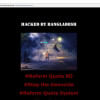Do government websites have enough public information?
The present government's aspiration of advancing the use of information technology and ensuring greater access to information is well known. These are important goals as the empowering value of information is well recognised and similarly, the use of information technology may create opportunities and help to reduce the gap between the people living in the urban and rural areas. Promoting the use of information technology is dependent on the availability of resources, but achieving the other objective, i.e. greater access to public information, is much less resource-dependent. At the least, mobilisation of governmental resources can make some progress in this regard. The government has made some strides in this regard and surely more public information is now available than in the past; but more can and needs to be achieved.
A common problem with some of the pieces of public information appearing on the various websites is that often these are presented in such a partial format that outsiders would hardly be able to make any reasoned analysis of them. They typically contain the achievements of a public body in such a fragmented way that third parties would be able to extract very little from them. Let us take the example of the various pieces of public information made accessible on the website of the Ministry of Land (http://www.minland.gov.bd/). It contains various types of information on the success of the ministry in the last few years, allocation of business among the various departments of the ministry, yearly lease value of land for tea gardens, settlement of agricultural khas land (land owned by government recorded in the name of Collectors), land acquisition and requisition laws, jolmohal (water bodies under the control of the government), and Information Publication Policy, 2015 etc.
However, upon closer scrutiny, the limited value of the above pieces of information made available would be easily evident. The information on land acquisition and requisition laws is nothing more than background information on the laws and tells us nothing regarding the actual quantity of land acquisitioned or requisitioned, or to what extent they have actually been used for the purpose for which they may have been acquisitioned or requisitioned. The information on the lease of tea gardens is only limited to the mentioning of the annual lease value of tea gardens and says nothing about the revenue earned from the land leased. The information on jolmohals is only limited to the district-wise number of jolmohals and the land area covered by them. Even the Annual Report 2014-2015 of the ministry, though containing some information on the ministry's various projects, does not shed much light on the missing pieces of information highlighted here.
Understandably, many of such missing pieces of information may not have been made public because they may not be available to the Ministry of Land itself. However, since under various laws, by-laws, and policies, land administrators are already required to report to their higher officials about their activities, it is perhaps possible if there is the willingness for opening these pieces of information to greater public scrutiny that can be achieved without much further expenditure. The purpose here is not to single out the Ministry of Land in this regard; the state of affairs in other ministries or departments may not be much different.
One can argue that since the promulgation of the Right to Information Act, 2009, interested analysts or members of the public can obtain desired information by utilising relevant provisions of this law. Indeed, to some extent, some investigative journalists and members of the public are already using this law to get the information which are of interest to them. However, despite that avenue being available, it has its limitations. First and foremost, it will take time and effort to access the necessary information. It is also possible that based on these requests, being addressed to specific office bearers, the information that is obtained would be limited to what is available to that particular office and may have limited use.
Of course, it may be wrong to assume that all public information contained in the websites of government ministries and departments are made available for public scrutiny. Some may be made available only for extolling the accomplishments of the respective departments, or simply for providing the public with some information on the activities of the government. Having said that, partial reporting would actually create only a mirage of transparency, missing the opportunity of achieving the full potential of the information which is made available to the public. Unless there are unavoidable reasons justifying partial secrecy, the information made available to the public should be as complete as possible, particularly when such information is already available to the public officers of the respective public bodies. Nothing less than a strong commitment to greater transparency can make them available to the public.
The writer is an Associate Professor at School of Law, BRAC University.

 For all latest news, follow The Daily Star's Google News channel.
For all latest news, follow The Daily Star's Google News channel. 




Comments